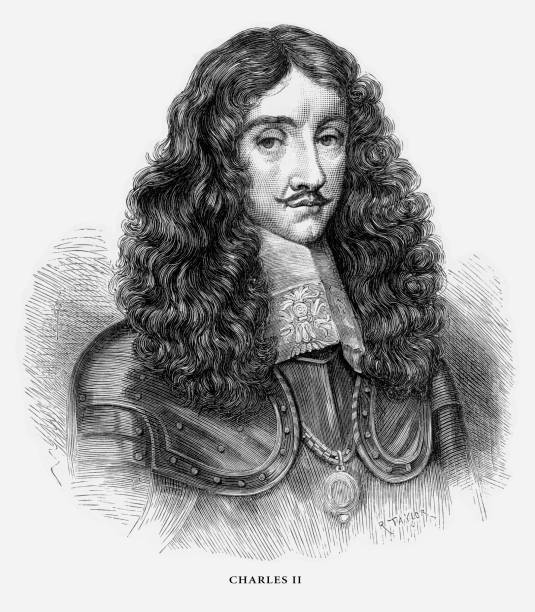
Very Rare, Beautifully Illustrated Antique Engraving of King Charles II, English Victorian Engraving, 1887. Source: Original edition from my own archives. Copyright has expired on this artwork. Digitally restored.
Browse 110+ king charles ii stock illustrations and vector graphics available royalty-free, or search for william penn or cavalier king charles spaniel to find more great stock images and vector art.

Very Rare, Beautifully Illustrated Antique Engraving of King Charles II, English Victorian Engraving, 1887. Source: Original edition from my own archives. Copyright has expired on this artwork. Digitally restored.
![KING CHARLES II, 1660-1685 ( XXXL with many details) Portrait of King Charles II of England, from a painting by Mrs, Beale.
Vintage engraving circa late 19th century. Digital restoration by Pictore.
Charles II (29 May 1630 – 6 February 1685)[c] was King of Scotland from 1649 until 1651 and King of England, Scotland and Ireland from the 1660 Restoration of the monarchy until his death in 1685. king charles ii stock illustrations](https://media.istockphoto.com/id/1619809249/vector/king-charles-ii-1660-1685.jpg?s=612x612&w=0&k=20&c=eq96YFHwKEMJqeTS0IvXGS7dKaDfxOah47k2NIl8dDI=)
Portrait of King Charles II of England, from a painting by Mrs, Beale. Vintage engraving circa late 19th century. Digital restoration by Pictore. Charles II (29 May 1630 – 6 February 1685)[c] was King of Scotland from 1649 until 1651 and King of England, Scotland and Ireland from the 1660 Restoration of the monarchy until his death in 1685.

Vintage engraving of King Charles II entering London on his restoration to the throne.

During the Civil War in England, King Charles II was forced to flee for his life from the Battle of Worcester. He sought refuge at Boscobel, initially in a tree (the ‘Boscobel Oak’) and then in a priest hole in Boscobel House before escaping to France. Woodcut from “Pleasant Hours: A Monthly Journal of Home Reading and Sunday Teaching; Volume III” published by the Church of England’s National Society’s Depository, London, in 1863.

Ships of Charles II of England from the second half of the 17th century. Woodcut engraving from the book "Das Buch der Erfindungen, Gewerbe und Industrien, Ergänzungsband: Weltverkehr (The book of inventions, commerce and industries, supplementary volume: World traffic)", published by Otto Spamer, Berlin and Leipzig, 7th Edition (1880)

Illustration published in 1891, out of copyright Isaac Newton (1642-1727) is in the President's chair.

Vintage engraved illustration - Charles II (1660-1685) King of England and Scotland

Charles II of England and his close friends having a conversation during a meal. (circa 17th century). Vintage etching circa 19th century.

Illustration of the old London bridge at the time of Charles II

From 13th century funeral effigies of monarchs and other royal persons were used in a funeral procession on the coffin. After the burial the effigy continued to be exhibited in the church and became the property of the Abbey authorities.

Very Rare, Beautifully Illustrated Antique Engraving of King Charles II, English Victorian Engraving, 1887. Source: Original edition from my own archives. Copyright has expired on this artwork. Digitally restored.

Charles II (630 - 1685), King of England, Scotland, and Ireland. Copper engraving, published in 1805.

King Charles II, monarch of the three kingdoms of England, Scotland, and Ireland.
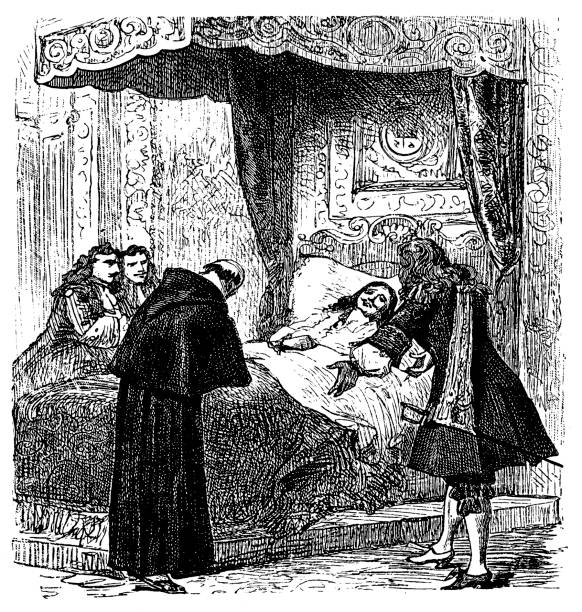
Illustration of a Charles II from his deathbed

Charles II - Scanned 1897 Engraving

Vintage engraving ofEnglish Civil War, Charles in the pub at Charmouth. Before he went away, the landlord came behind his chair

Charles II travelling in disguise to escape after the Civil War in England (circa 17th century). Vintage etching circa 19th century.

Charles II (May 29, 1630 –February 6, 1685) was restored to the throne in 1660 after Oliver Cromwell died and his son was ineffective as Lord Protector. Woodcut engraving published 1846. Original edition from a history book is in my own archives. Copyright has expired and is in Public Domain.

Horse and carriages stagecoaches moving round green in Soho in 18th Century. Was originally called King Square after Charles II. The statue of Charles II has stood since the square's 1661 founding.

"Vintage engraving of King Charles the Second of England 29 May 1630 aa 6 February 1685. Engraving from 1857 phot by D Walker. He was popularly known as the Merrie Monarch, in reference to both the liveliness and hedonism of his court and the general relief at the return to normality after over a decade of rule by Oliver Cromwell and the Puritans."

Antique engraved image of King Charles. Engraving by Gusman after a work by Luc-Olivier Merson. Isolated on white.

The original Royal Oak where Charles II hid while escaping capture at Boscobel House in Staffordshire, England (circa 18th century). Vintage etching circa 19th century. The Royal Oak was badly damaged and eventually destroyed by tourists removing pieces as souvenirs.

Illustration excerpt from ‘A Child’s History of Scotland’ by Margaret Oliphant. First published in 1895, it contains the Children’s study of history of Scottish Royalty, Kings, Queens and battles. Here we see an illustration of King James IV travelling on his throne, surrounded by knights on horseback.

Illustration published in 1891, out of copyright Popish plot Charles II

Vintage illustration, History of fashion, Mens costumes from the reign of Charles II of England 17th Century

Charles II, King of England having a lively party with his friends (circa 17th century). Vintage etching circa 19th century.

A Royalist soldier mending his horse’s harness buckle during an English Civil War battle. The horse’s harness bears the arms of King Charles II. From “The Cottager and Artisan: The People’s Own Paper” published in 1898 by The Religious Tract Society, London.

Portrait of Charles II, king of England, Scotland, and Ireland from 1660 to his death in 1685. King Charles was born May 29, 1630, and died February 6, 1685. Illustration published in The New Eclectic History of the United States by M. E. Thalheimer (American Book Company; New York, Cincinnati, and Chicago) in 1881 and 1890. Copyright expired; artwork is in Public Domain.

Vintage engraved illustration isolated on white background - Shilling and Halfpenny coin of Charles II (1660-1685) King of England and Scotland

Charles II (1630 - 1685) - king of England, Scotland, and Ireland. Wood engraving, published in 1876.

Vintage illustration of King Charles II of England
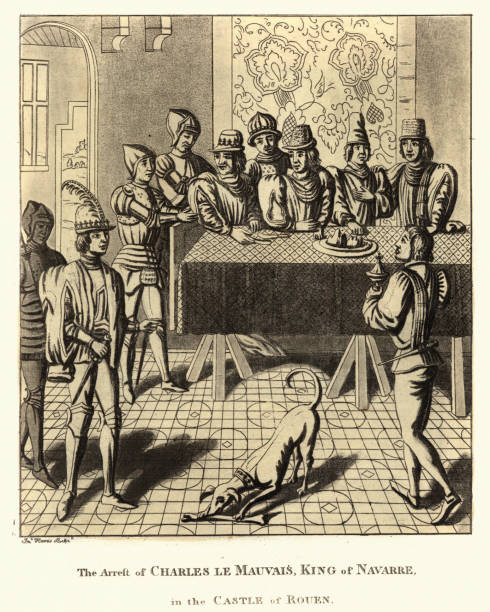
Vintage engraving of a scene from Froissart's Chronicles. John the Good, king of France, ordering the arrest of Charles the Bad, king of Navarre, 1356
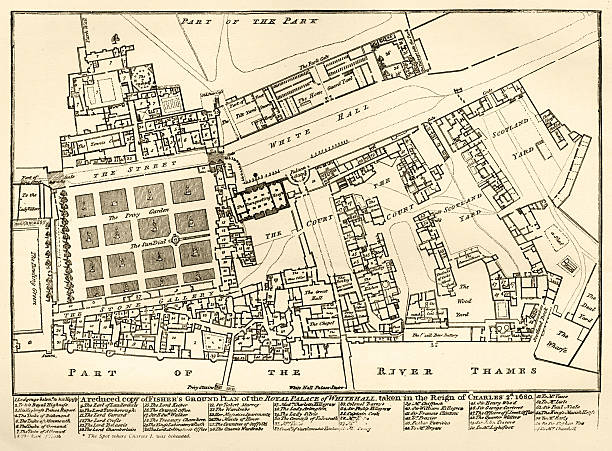
A ground plan of the old Royal Palace of Whitehall beside the River Thames in London. The Palace was an enormous collection of buildings and courtyards which was the main home of British monarchs until 1698 when much of the Palace was destroyed by fire. This plan was drawn up in 1680, during the reign of King Charles II. From “Old & New London” by Walter Thornbury and Edward Walford, published in parts by Cassell & Co, London from 1873-1888. These illustrations are from parts 30-35 inclusive.

Antique dotprinted photo of paintings: Charles II at Whiteladies

Antique dotprinted photo of paintings: Charles II and Lady Castlemaine

King Charles II expand his aviaries along Birdcage Walk. He appointed Edward Storey as “Keeper of the King’s Birds” and assigned him Storey’s Gate as his lodge. Now a cafe is a hidden Royal secret home

Antique dotprinted photo of paintings: Charles II at Whiteladies

Kirby warning King Charles II of the assassination plot

King Charles II entering London on the restoration of the Monarchy.

Illustration published in 1891, out of copyright

When British King Charles II changed Colonel Careless's name to Carlos, he gave him a family coat of arms with three royal crowns and the oak tree to show where they hid together from the Parliamentary soldiers. Illustration published 1863. Original edition is from my own archives. Copyright has expired and is in Public Domain.

John Bunyan, author of Pilgrim's Progress, is arrested while preaching at a farmhouse in 1660. Bunyan was a Puritan Protestant and the English King Charles II was Catholic. Bunyan was imprisoned 12 years for refusing to denounce his faith the first time. It was during a second stint in prison that Bunyan wrote the famous Christian allegory. Illustrations are Wood Engraving by William Harvey for Pilgrim’s Progress by John Bunyan, plus a memoir on Bunyan by George Cheever D.D., and Bunyan's apologetics for Pilgrim's Progress (William L. Allison Co. Publishers: NY) published in 1856. The first edition is in my private collection. Copyright is in public domain.

Antique illustration (1898): Scottish Mark, Charles II, 1669
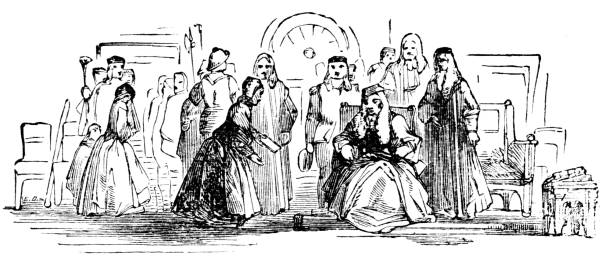
Elizabeth Bunyan petitions the courts for his release from prison. John Bunyan, author of Pilgrim's Progress, was imprisoned in Bedford for preaching. Bunyan was a Puritan Protestant, and the English King Charles II was Catholic. Bunyan was imprisoned 12 years for refusing to denounce his faith the first time. It was during a second stint in prison that Bunyan wrote the famous Christian allegory. Illustrations are Wood Engraving by William Harvey for Pilgrim’s Progress by John Bunyan, plus a memoir on Bunyan by George Cheever D.D., and Bunyan's apologetics for Pilgrim's Progress (William L. Allison Co. Publishers: NY) published in 1856. The first edition is in my private collection. Copyright is in public domain.
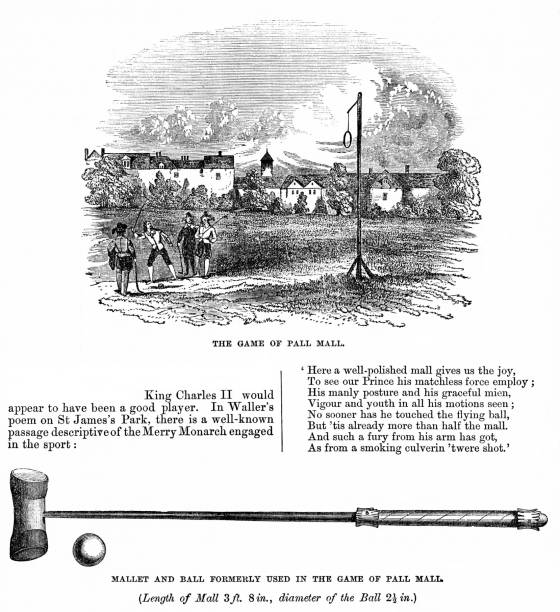
Game of Pall-Mall using balls, mallet, and a hoop outdoors. Illustration includes four male teens playing the game, close-up of equipment, and a poem about Kind Charles II playing Pall-Mall while a prince of England. Illustration published 1863. Original edition is from my own archives. . Copyright has expired and is in Public Domain.

Illustration of a Motives from the time of the Spanish War of Succession. Spain under Charles II

Illustration of a King Charles II

"Antique illustration of a 17th-century British half crown coin. Published in Systematische Bilder-Gallerie, Karlsruhe und Freiburg (1839)."

Charles II of England - Scanned 1884 Engraving

Engraving from 1896 showing Charles II.

Vintage engraved illustration - Escape of Charles II (King of England and Scotland) after the Battle of Worcester

The English Civil War (1642–1651) was a series of civil wars and political machinations between Parliamentarians ("Roundheads") and Royalists ("Cavaliers"), It was part of the wider Wars of the Three Kingdoms. Pitted the supporters of King Charles I against the supporters of the Long Parliament, King Charles II and supporters of the Rump Parliament. The war ended with Parliamentarian victory at the Battle of Worcester on 3 September 1651.

Vintage engraving of King Charles the Second of England 29 May 1630 – 6 February 1685. Engraving from 1857 phot by D Walker. He was popularly known as the Merrie Monarch, in reference to both the liveliness and hedonism of his court and the general relief at the return to normality after over a decade of rule by Oliver Cromwell and the Puritans.
© 2025 iStockphoto LP. The iStock design is a trademark of iStockphoto LP. Browse millions of high-quality stock photos, illustrations, and videos.
Do Not Sell or Share